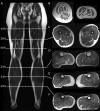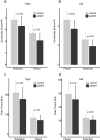Muscle fat replacement and contractility in patients with skeletal muscle sodium channel disorders
- PMID: 36782059
- PMCID: PMC9925746
- DOI: 10.1038/s41598-023-29759-7
Muscle fat replacement and contractility in patients with skeletal muscle sodium channel disorders
Abstract
Skeletal muscle sodium channel disorders give rise to episodic symptoms such as myotonia and/or periodic paralysis. Chronic symptoms with permanent weakness are not considered characteristic of the phenotypes. Muscle fat replacement represents irreversible damage that inevitably will impact on muscle strength. This study investigates muscle fat replacement and contractility in patients with pathogenic SCN4A variants compared to healthy controls. T1-weighted and 2-point Dixon MRI of the legs were conducted to assess fat replacement. Stationary dynamometry was used to assess muscle strength. Contractility was determined by maximal muscle contraction divided by cross-sectional muscle area. The average cross-sectional intramuscular fat fraction was greater in patients compared with controls by 2.5% in the calves (95% CI 0.74-4.29%, p = 0.007) and by 2.0% in the thighs (95% CI 0.75-3.2%, p = 0.003). Muscle contractility was less in patients vs. controls by 14-27% (p < 0.05). Despite greater fat fraction and less contractility, absolute strength was not significantly less. This study quantitatively documents greater fat fraction and additionally describes difference in muscle contractility in a large cohort of patients with skeletal muscle sodium channel disorders. The clinical impact of these abnormal findings is likely limited as muscle hypertrophy in the patients served to preserve absolute muscle strength. Subgroup analysis indicated significant difference in phenotype by genotype, however these findings lack statistical significance and serve as inspiration for future researchers to probe into the geno- phenotype relationship in these disorders.Trial registration: The study was registered at http://clinicaltrials.gov (identifier: NCT04808388).
© 2023. The Author(s).
Conflict of interest statement
The authors declare no competing interests.
Figures






References
MeSH terms
Substances
Associated data
LinkOut - more resources
Full Text Sources
Medical

